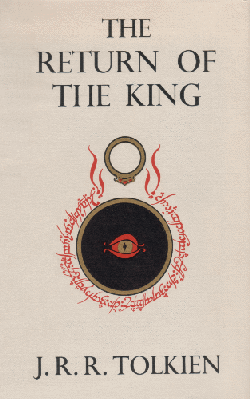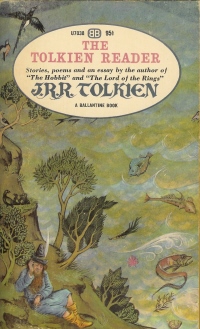
Tom Bombadil is a character in J. R. R. Tolkien's legendarium. He first appeared in print in a 1934 poem called "The Adventures of Tom Bombadil", which also included The Lord of the Rings characters Goldberry, Old Man Willow and the Barrow-wight, from whom he rescues the hobbits. They were not then explicitly part of the older legends that became The Silmarillion, and are not mentioned in The Hobbit.
Goldberry is a character from the works of the author J. R. R. Tolkien. She first appeared in print in a 1934 poem, The Adventures of Tom Bombadil, where she appears as the wife of Tom Bombadil. Also known as the "River-woman's daughter", she is described as a beautiful, youthful woman with golden hair. She is best known from her appearance as a supporting character in Tolkien's high fantasy epic The Lord of the Rings, first published in 1954 and 1955.
The Rings of Power are magical artefacts in J. R. R. Tolkien's legendarium, most prominently in his high fantasy novel The Lord of the Rings. The One Ring first appeared as a plot device, a magic ring in Tolkien's children's fantasy novel, The Hobbit; Tolkien later gave it a backstory and much greater power. He added nineteen other Great Rings, also conferring powers such as invisibility, that it could control, including the Three Rings of the Elves, Seven Rings for the Dwarves, and Nine for Men. He stated that there were in addition many lesser rings with minor powers. A key story element in The Lord of the Rings is the addictive power of the One Ring, made secretly by the Dark Lord Sauron; the Nine Rings enslave their bearers as the Nazgûl (Ringwraiths), Sauron's most deadly servants.

The Return of the King is the third and final volume of J. R. R. Tolkien's The Lord of the Rings, following The Fellowship of the Ring and The Two Towers. It was published in 1955. The story begins in the kingdom of Gondor, which is soon to be attacked by the Dark Lord Sauron.
The Red Book of Westmarch is a fictional manuscript written by hobbits, related to the author J. R. R. Tolkien's frame stories. It is an instance of the found manuscript conceit, a literary device to explain the source of his legendarium. In the fiction, it is a collection of writings in which the events of The Hobbit and The Lord of the Rings were recounted by their characters, and from which Tolkien supposedly derived these and other works. The name of the book comes from its red leather binding and casing, and from its having been housed in the Westmarch, a region of Middle-earth next to the Shire.
In J. R. R. Tolkien’s fictional universe of Middle-earth, the Old Forest was a daunting and ancient woodland just beyond the eastern borders of the Shire. Its first and main appearance in print was in the chapter of the 1954 The Fellowship of the Ring titled "The Old Forest". The hobbits of the Shire found the forest hostile and dangerous; the nearest, the Bucklanders, planted a great hedge to border the forest and cleared a strip of land next to it. A malign tree-spirit, Old Man Willow, grew beside the River Withywindle in the centre of the forest, controlling most of it.

"The Man in the Moon Stayed Up Too Late" is J. R. R. Tolkien's imagined original song behind the nursery rhyme "Hey Diddle Diddle ", invented by back-formation. It was first published in Yorkshire Poetry magazine in 1923, and was reused in extended form in the 1954–55 The Lord of the Rings as a song sung by Frodo Baggins in the Prancing Pony inn. The extended version was republished in the 1962 collection The Adventures of Tom Bombadil.
The following outline is provided as an overview of and topical guide to the real-world history and notable fictional elements of J. R. R. Tolkien's fantasy universe. It covers materials created by Tolkien; the works on his unpublished manuscripts, by his son Christopher Tolkien; and films, games and other media created by other people.
"Errantry" is a three-page poem by J.R.R. Tolkien, first published in The Oxford Magazine in 1933. It was included in revised and extended form in Tolkien's 1962 collection of short poems, The Adventures of Tom Bombadil. Donald Swann set the poem to music in his 1967 song cycle, The Road Goes Ever On.

The Tolkien Reader is an anthology of works by J. R. R. Tolkien. It includes a variety of short stories, poems, a play and some non-fiction. It compiles material previously published as three separate shorter books, together with one additional piece and introductory material. It was published in 1966 by Ballantine Books in the USA.
This is a list of all published works of the English writer and philologist J. R. R. Tolkien. Tolkien's works were published before and after his death.
"The Sea-Bell" or "Frodos Dreme" is a poem with elaborate rhyme scheme and metre by J.R.R. Tolkien in his 1962 collection of verse The Adventures of Tom Bombadil. It was a revision of a 1934 poem called "Looney". The first-person narrative speaks of finding a white shell "like a sea-bell", and of being carried away to a strange and beautiful land.

In J. R. R. Tolkien's fantasy The Lord of the Rings, Old Man Willow is a malign tree-spirit of great age in Tom Bombadil's Old Forest, appearing physically as a large willow tree beside the River Withywindle, but spreading his influence throughout the forest. He is the first hostile character encountered by the Hobbits after they leave the Shire.
Frodo Baggins is a fictional character in J. R. R. Tolkien's writings, and one of the protagonists in The Lord of the Rings. Frodo is a hobbit of the Shire who inherits the One Ring from his cousin Bilbo Baggins, described familiarly as "uncle", and undertakes the quest to destroy it in the fires of Mount Doom in Mordor. He is mentioned in Tolkien's posthumously published works, The Silmarillion and Unfinished Tales.

The Fellowship of the Ring is the first of three volumes of the epic novel The Lord of the Rings by the English author J. R. R. Tolkien. It is followed by The Two Towers and The Return of the King. The action takes place in the fictional universe of Middle-earth. The book was first published on 29 July 1954 in the United Kingdom. The volume consists of a foreword, in which the author discusses his writing of The Lord of the Rings, a prologue titled "Concerning Hobbits, and other matters", and the main narrative in Book I and Book II.
The poetry in The Lord of the Rings consists of the poems and songs written by J. R. R. Tolkien, interspersed with the prose of his high fantasy novel of Middle-earth, The Lord of the Rings. The book contains over 60 pieces of verse of many kinds; some poems related to the book were published separately. Seven of Tolkien's songs, all but one from The Lord of the Rings, were made into a song-cycle, The Road Goes Ever On, set to music by Donald Swann. All the poems in The Lord of the Rings were set to music and published on CDs by The Tolkien Ensemble.
Tolkien's Middle-earth family trees contribute to the impression of depth and realism in the stories set in his fantasy world by showing that each character is rooted in history with a rich network of relationships. J. R. R. Tolkien included multiple family trees in both The Lord of the Rings and The Silmarillion; they are variously for Elves, Dwarves, Hobbits, and Men.
J. R. R. Tolkien used frame stories throughout his Middle-earth writings, especially his legendarium, to make the works resemble a genuine mythology written and edited by many hands over a long period of time. He described in detail how his fictional characters wrote their books and transmitted them to others, and showed how later in-universe editors annotated the material.

J. R. R. Tolkien was attracted to medieval literature, and made use of it in his writings, both in his poetry, which contained numerous pastiches of medieval verse, and in his Middle-earth novels where he embodied a wide range of medieval concepts.

J. R. R. Tolkien included many elements in his Middle-earth writings, especially The Lord of the Rings, other than narrative text. These include artwork, calligraphy, chronologies, family trees, heraldry, languages, maps, poetry, proverbs, scripts, glossaries, prologues, and annotations. Scholars have stated that the use of these elements places Tolkien in the tradition of English antiquarianism.









